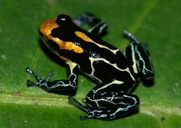|
Ranitomeya fantastica (Boulenger, 1884)
Crowned Poison Frog, Red-headed Poison Frog | family: Dendrobatidae subfamily: Dendrobatinae genus: Ranitomeya |
 © 2016 Tiffany Kosch (1 of 21) |
|
|
|
Description Diagnosis: R. fantastica can be distinguished from R. tinctorius by its longer limbs, and a tarso-metatarsal articulation that goes beyond the tip of the snout. It can be distinguished from D. tinctorius and R. reticulata by its granulated belly (Boulenger 1884). Distribution and Habitat Country distribution from AmphibiaWeb's database: Peru
Life History, Abundance, Activity, and Special Behaviors Trends and Threats Relation to Humans Possible reasons for amphibian decline General habitat alteration and loss Comments Its sister group is comprised of R. reticulata and is inside the ventrimaculata group within the Dendrobatidae species (Noonan and Wray 2006). The original species was recently revised into a complex of closely related species including R. summersi and R. benedicta (Brown et al. 2008b)
References
Boulenger, G. A. (1884). ''On a collection of frogs from Yurimaguas, Huallaga River, Northern Peru.'' Proceedings of the Zoological Society of London , (1883), 635-638. Brown, J. L., Morales, V., and Summers, K. (2008). ''Divergence in parental care, habitat selection and larval life history between two species of Peruvian poison frogs: an experimental analysis.'' Journal of Evolutionary Biology, 21, 1534-1543. Brown, J. L., Twomey, E., Pepper, M., and Sanchez Rodriguez, M. (2008). ''A revision of the Ranitomeya fantastica species complex and two new species of poison frogs (Anura: Dendrobatidae) from the Rio Huallaga drainage in central Peru.'' Zootaxa, 1832, 1-24. Icochea, J., Angulo, A., and Jungfer, K.-H. (2004). Ranitomeya fantastica. In: IUCN 2010. IUCN Red List of Threatened Species. Version 2010.4. www.iucnredlist.org. Downloaded on 28 April 2011 Noonan, B. P., and Wray, K. P. (2006). ''Neotropical diversification: the effects of a complex history on diversity within the poison frog genus Dendrobates.'' Journal of Biogeography, 33(6), 1007-1020. Originally submitted by: Brianne Milano, David Strunk, and Jason Saenz (first posted 2010-09-28) Edited by: Mingna (Vicky) Zhuang (2012-03-19) Species Account Citation: AmphibiaWeb 2012 Ranitomeya fantastica: Crowned Poison Frog <https://amphibiaweb.org/species/1630> University of California, Berkeley, CA, USA. Accessed May 29, 2025.
Feedback or comments about this page.
Citation: AmphibiaWeb. 2025. <https://amphibiaweb.org> University of California, Berkeley, CA, USA. Accessed 29 May 2025. AmphibiaWeb's policy on data use. |



 Map of Life
Map of Life